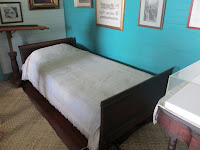“Come not between the
dragon and his wrath.” William
Shakespeare, “King Lear”
The world’s largest breed of lizard is also the most
dangerous: the komodo dragon. National
Geographic says, “As the
dominant predators on the handful of islands they inhabit, they will eat almost
anything, including carrion, deer, pigs, smaller dragons, and even large water
buffalo and humans.”
The
male dragons can get as large as 300 pounds, and the females about half
that. They have tremendously large
and powerful jaws. A dozen of them
can take down a water buffalo in a matter of minutes. Or a human. But
deer are apparently their favorite food.
They also will eat one another, and it’s not uncommon for a male to eat
the eggs fertilized by another male.
Since the mother lays the eggs and then guards the nest for only part of
the gestation period, the eggs can be particularly vulnerable. Newborns are
similarly vulnerable, since by the time they hatch the mother is long gone and
they are on their own. And their biggest threat is their own kind.
Komodo
Island, the place that we visited yesterday, is their primary habitat, though
they can be found on three other nearby islands. Apparently they have a very
acute sense of smell, and are particularly attracted to the smell of blood
(land shark, anyone?). So we were
instructed ahead of time that no one with open sores should go ashore, nor
anyone menstruating. Also, no one would be allowed to wander alone on the
island, because of how dangerous these animals can be.
And, if a dragon comes after you, forget
climbing a tree to get away—the younger ones are good climbers. And don’t try going in the water—you’re
likely to encounter them swimming as well.
Not
surprisingly, these cautions left us with a bit of foreboding, but 700 of the approximately 900 people on the ship went ashore, so there was not enough concern to stop us
from this unique experience.
Once
ashore, we were assigned to groups of about 20, with each group having three
local escorts: a naturalist who walked at the head of the group carrying the
“defense weapon” (a stick with two prongs on the end--check what's in the ranger's hand in the photo below), and watchers in the
middle and at the back of the group.
We were instructed to talk quietly, if we must talk at all, and not to
dangle anything (cameras, jewelry, purses, etc), or use flash on our
cameras. In other words, do
nothing to attract their attention.
We
proceeded to walk a trail of about a mile through the place where the komodo
dragons roam. We’d no sooner
started than we spotted a young dragon across a ditch. Alas, I was unable to get a good photo
of him, even though he stopped periodically and struck a pose. According to the naturalist, he was
likely checking the area for threats or food.
That
was the last dragon we would see, until we reached a watering hole, where about
eight of them were lounging. There
was only one female among them; the rest were the larger males. Our guide informed us that all the
dragons there were likely “middle aged”—40 years old, give or take. Life spans of komodo dragons can vary
depending on food supply. The average is 57, though they can live as long as 80
years or more.
Of
course, someone had to ask: have
they ever lost a human to a komodo dragon? The guide’s tactful answer: “it has happened.”
So, when was the last attack on a human? The last one he knew about was two years ago, on another of
the islands where they live (and, in fact, the island where he lives). That person survived, and was airlifted
to a hospital in Bali.
At
the end of the day, the ship’s captain happily announced that all who had gone
ashore had returned to the ship, and all with limbs intact. It was one of the more interesting
days.
As I
write this, we are within sight of Bali, having essentially been circling it
all morning. We were initially scheduled to dock this morning, but were unable
to sail in because of the direction of the currents and the level of the tides. We expect to dock in about two hours,
meaning our three scheduled days in Bali are now two and one half days. Fortunately, the guide we’d lined up
for today was able to accommodate us tomorrow, so we’re looking forward to an
exploration tomorrow.















